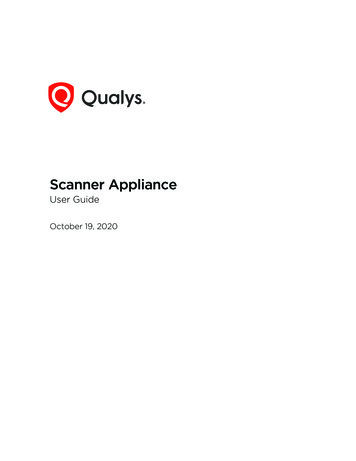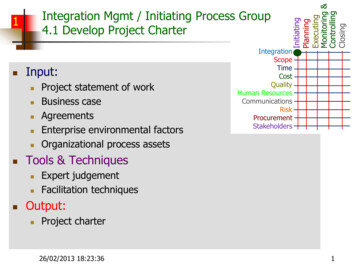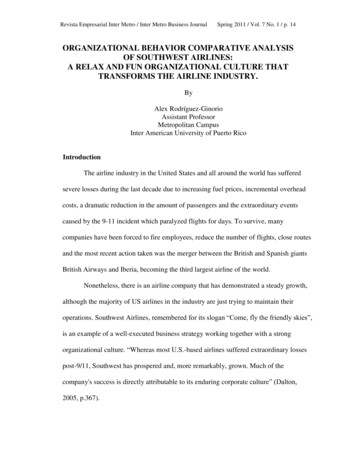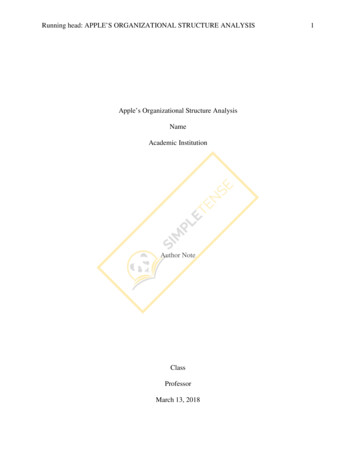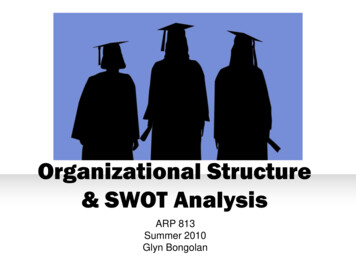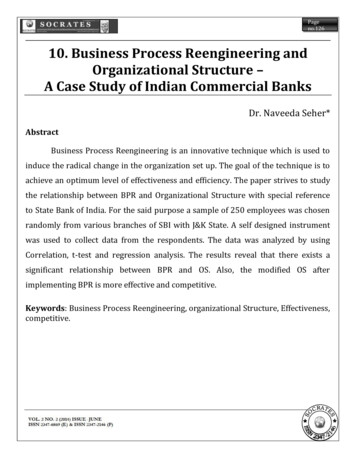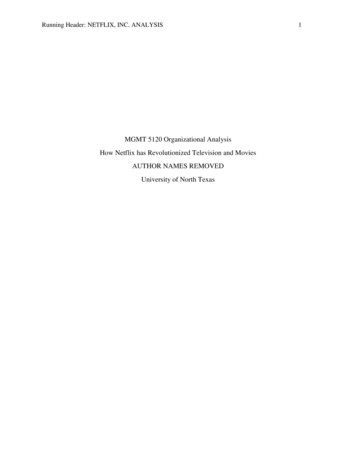
Transcription
Running Header: NETFLIX, INC. ANALYSISMGMT 5120 Organizational AnalysisHow Netflix has Revolutionized Television and MoviesAUTHOR NAMES REMOVEDUniversity of North Texas1
NETFLIX, INC. ANALYSIS2Module 1: Organizations and Organizational EffectivenessFounded in 1997 by Reed Hastings and Marc Rudolph, Netflix, Inc. (Netflix or “thecompany”) is the pioneer and, arguably, global leader, of streaming television and movies today.But this is a far cry from Netflix’s original business model.At its origin, Netflix was in the business of selling DVDs. At the time, the VHS tape wasthe dominant technology in video. While Hastings and Rudolph knew they had a potentiallygroundbreaking idea in using e-commerce to sell movies to the public, the logistics just weren’tfeasible due to the high purchasing and shipping costs of VHS tapes. Months later, according toRudolph, the pair learned of a new format that was being tested, the DVD. After testing the easeand cost of delivering a DVD, they realized that their idea, which had been shelved monthsearlier, could possibly be brought back to life (Xavier, 2014).Since 1997, Netflix has evolved into a DVD rental service, to adding its streamingservice in 2007, to what it is today – an online, global, streaming empire with over 75 millioncustomers in over 190 countries (Netflix, Inc. 10-K, 2016, About Us section). Today, customerscan view TV shows, documentaries, and feature films, much of which includes the company’sown original, award-winning programming. According to Netflix’s Company Profile, thebenefits of watching shows and movies in this format, as opposed to traditional, linear TVformatting, is that “Members can play, pause and resume watching, all without commercials orcommitments” (Company Profile, n.d.).In order to continue being at the forefront of the streaming programming industry, Netflixis closely focused on the ability to be viewed on as many Internet-connected screens as possible.To make this possible, according to the company’s 2015 Annual Report, Netflix has adapted acore strategy which is to “grow our streaming membership business globally ”, and are
NETFLIX, INC. ANALYSIS3continuing to advance the services provided to its members by “expanding our streaming contentwith a focus on a programming mix of content that delights our members. In addition, we areperpetually enhancing our user interface and extending our streaming service to more Internetconnected screens” (Netflix, Inc. 10-K, 2016, About Us section).In a society ruled by instant gratification and busy schedules, Netflix creates value for itsmembers by having content readily available on multiple devices at any given time, and bygiving each member the ability to watch, re-watch, pause, and resume watching at any time ofhis or her choosing. Additionally, the company still provides DVD rentals delivered to U.S.customers’ mailboxes, if they so choose.In Appendix A, you will find a model of the four processes – inputs, throughputs, outputs,and environment – through which Netflix creates this value for its members.Inputs. Though most of Netflix’s services are web-based and, therefore, require muchless in raw materials than many companies, DVDs are needed for the U.S. customers who stillutilize this service. The company continues to build upon the services offered and requires morespecialized professionals as the complexity grows. For example, with the debut of their firstoriginal programming in 2013, Netflix became the employer of Hollywood stars, producers,directors, and crews, which is far from the Silicon Valley elite and content experts that formerlymade up the majority of the payroll.Throughputs. As of January 2016, Netflix closed all of its data centers that were used forthe streaming content and moved everything to the “cloud”, specifically to Amazon WebServices (AWS) (Darrow, 2016). During the throughput process, many things are happening.Negotiations between Netflix and owners of viewing material are taking place, those thousands
NETFLIX, INC. ANALYSIS4of hours of programming are being stored and accessed from web services, and employees areconstantly being trained in computer technology, acting, producing, talent search, etc.Outputs. Assuming that everything runs smoothly in the throughput process, the resultthat is available to the public is countless hours of programming to stream at each member’sdesire, and thousands of DVDs from which to choose to rent.Environment. Netflix’s major suppliers are AWS, as well as those who supply DVDs.The population from which Netflix can choose its employees has changed drastically. Whilemost of the talent was previously found from sources such as Silicon Valley and various techrelated companies, that population has grown to include Hollywood and other sources of actors,directors, camera operators, etc. While the company sees its customers and potential customersas largely being a population of viewers who like the “freedom of on-demand and the fun ofbinge viewing” (“Netflix’s View”, n.d., Netflix Focus section), it is necessary to broaden that towhat is referred to as cord-cutters, those who do away with traditional cable or satellite TV. Onestudy, conducted by Jan Dawson of MarketWatch.com, found that, from Q2 2015 to Q2 2016, anastounding 834,000 pay-TV customers did away with their subscriptions (Dawson, 2016, para.4). This provides a large market of potential Netflix members. In direct competition with Netflixare Hulu, Amazon, network streaming apps, and even piracy (“Netflix’s View”, n.d.,Competition section).As with any company, Netflix does face potential risks, and has outlined many of these inthe 2015 Annual Report. One risk the company sees as one that is very hard to combat is piracy.Because the “free content” of pirated material is attractive to members or potential members, it isespecially difficult for the company to tackle (Netflix, Inc. 10-K, 2016, Changes incompetitive section). Additionally, there are potential issues with the way in which Netflix
NETFLIX, INC. ANALYSIS5enters into contracts with content providers in conjunction with the structure of the membershipprocess. That is, the company enters into multi-year contracts with content providers, but this isexclusive of any membership numbers at a given point in time, and those memberships are on ano-commitment basis and can be cancelled at any time. Therefore, the company could possiblysee a decline in memberships while still being held to commitments with content providersduring that time (Netflix, Inc. 10-K, 2016, The long-term and fixed cost section). One morerisk that Netflix sees as a possibility is with its international business. Because the company isvery new to the global market, there are still many unknowns. There are needs to adapt tocultures and languages, to consider potential tax consequences and new competition sources, andto have a complete understanding of regulatory laws and censorship requirements in eachcountry in which the company operates and, finally, to keep a strong focus on currency andexchange rate risks (Netflix, Inc. 10-K, 2016, We could be subject to economic section).When asked about long-term goals for streaming in the U.S., Netflix explained that itstarget is to reach 40% contribution by 2020 and that it would evaluate the success of this goal atthat time (Top Investor Questions, n.d., What are your long-term margins section).Netflix is continuously looking for ways to increase efficiency, as with the move toAWS. According to Darrow’s report on Forbes.com, cloud providers can do a much moreefficient job of storing and delivering data than most companies can, and Netflix has been able touse this to its advantage by being able to deliver its content faster and more efficiently to itsmembers (Darrow, 2016).
NETFLIX, INC. ANALYSIS6Module 2: Stakeholders, Managers, and EthicsReed Hastings, CEO and co-founder of Netflix, also serves as President and Chairman of theBoard for the company. Mr. Hastings also serves on the board of Facebook and severaleducational non-profit organizations.To get a visual of the organizational chart of the entire top management team, please referto Appendix B. In addition to Hastings, the nine members of the board of directors consist ofexecutives and former executives of companies such as Zillow Group, Microsoft, MGM, 21stCentury Fox, Viacom and Disney.Netflix’s Code of Ethics, which is available on its website, outlines what the companyfeels is appropriate conduct in order to deter wrongdoing. These behaviors include, but are notlimited to, honest and ethical conduct, full and accurate disclosures in reporting, acting inaccordance to government laws, prompt internal reporting, and individual accountability forbehaving by the Code. Additionally, managers and employees are expected to act with integrity,and must not use their employment with the company to obtain personal benefits (Code ofEthics, n.d.).While the company strives to uphold these standards of behavior, this has not alwaysbeen the case with every employee. In 2014, a lawsuit was filed by Netflix against its former VPof IT operations, Mike Kail. Court documents cited Breach of Fiduciary Duty, among otherclaims (Norton, 2015). The lawsuit is ongoing at this time.Module 3: Organizing in a Changing Global EnvironmentAt its current state of operations, the products Netflix provides to its customers can bebroken down into four broad categories: DVD rental service, licensed content, Netflix-originalprogramming, and international/foreign language programming. Because of the overwhelming
NETFLIX, INC. ANALYSIS7success of original content such as House of Cards and Orange is the New Black, the companyexpects to invest an increasing amount of money on developing more of its original content, andexpects the percentage of overall money spent on originals to increase as well in the near future(Top Investor Questions, n.d., What percent of your content spend section). If this trendcontinues, Netflix could very well set itself apart from its competition once again by providing aquality product that others have not yet been able to replicate with equal success.Netflix’s customer base, as well as potential customer base, is rapidly growing.Originally popular amongst mostly millennials, the number of internet TV viewers is increasingacross all demographics. In a study conducted by Deloitte, and published on Forbes.com, thepercentage of viewers who now include internet TV in their normal viewing schedule increasedfrom 10% in 2011 to 37% in 2013. Within those viewers, the percentage of “boomers” increasedfrom 6% to 22% within the same time period, and “matures” (67 ) increased from 2% to 11%(Hughes, 2015, para. 6).Netflix faces numerous forces in its general and specific environments, as modeled inAppendix C. Of these, the forces that likely have the most impact on the company’s operationsare their competitors, technological forces, and international forces.Because Netflix is considered to be the leader of the Internet TV industry, the company islikely to face fierce competition with every move it makes. To illustrate, Jeff Bezos, AmazonCEO, stated in July of this year that the company planned to double its original programmingbudget in order to be more competitive with Netflix (Geddes, 2016).Additionally, due to the nature of the business, technological forces in the generalenvironment should not be ignored. One major technological challenge Netflix constantly facesis making sure that their millions of members, many of whom have multiple devices with
NETFLIX, INC. ANALYSIS8streaming capability, are able to view programming without connection issues or interruptions(Jacobson, 2016).Finally, because of the company’s emerging presence and rapid growth in the globalmarket, international forces play a key role in its business. Operating in 190 countries means 190governments whose laws and regulations can directly affect the manner in which the companydoes business, what programs are allowed to be viewed, and/or how much and what kind ofcensorship is required (Netflix, Inc. 10-K, 2016, We could be subject to economic section).At its inception, Netflix had a relatively non-complex environment. There was one typeof product that was provided, virtually no direct competition, and the complexity came from thevarious content owners with which the company signed licensing agreements, as well as from theuncertainty of creating a new type of industry. Today, the environment is much more complex.The number of streaming content providers grows each year, and companies such as Hulu andAmazon had added original content of their own in order to compete with Netflix. The UnitedStates has, as of September 30, 2016, given up control of the Internet which has many wonderingwhat type of censorship or other effects may be on the horizon, leading to further uncertainty forweb-based companies such as Netflix (Crovitz, 2016). Finally, global expansion contributesgreatly to the environmental complexity by adding more governmental regulations, possiblepolitical unrest in certain areas, and possibilities for new competitors (Netflix, Inc. 10-K, 2016,We could be subject to economic section).Environmental dynamism, “the degree to which forces in the specific and generalenvironments change quickly over time and thus contribute to the uncertainty an organizationfaces” (Jones, 2013, p. 67), is extremely high in the environment in which Netflix operates. Notonly has the company seen numerous changes in its relatively young existence, but one could
NETFLIX, INC. ANALYSIS9argue that it has created much of the dynamism. As of 2016, some of the largest names in cable,programming, and entertainment are making efforts to enter into the streaming TV whirlwind.Companies such as Dish Network, Sony PlayStation Vue, Amazon, Apple, YouTube (Google),and AT&T’s DirecTV are all trying to enter into, or further their presence i
Founded in 1997 by Reed Hastings and Marc Rudolph, Netflix, Inc. (Netflix or “the company”) is the pioneer and, arguably, global leader, of streaming television and movies today. But this is a far cry from Netflix’s original business model.


